Presented here down the page you will find additional sound advice around Prevent Freezing and Bursting Pipes.

All homeowners that live in pleasant climates must do their finest to winterize their pipelines. Failure to do so can spell catastrophe like icy, fractured, or ruptured pipes.
Attempt a Hair Dryer or Warmth Gun
When your pipelines are almost freezing, your trusty hair dryer or warm weapon is a godsend. Bowling hot air straight right into them may aid if the hot towels do not assist displace any working out ice in your pipes. Nonetheless, do not utilize other objects that produce direct flames like a strike torch. This can cause a bigger catastrophe that you can not control. You may wind up destructive your pipes while attempting to melt the ice. As well as over time, you may also wind up shedding your residence. Be careful!
Open Cupboard Doors Hiding Plumbing
When it's chilly outside, it would be practical to open cupboard doors that are camouflaging your pipes. For example, they could be somewhere in your cooking area or bathroom. This will allow the cozy air from your heater to flow there. Consequently, you prevent these exposed pipelines from freezing. Doing this small trick can keep your pipelines warm and limit the potentially harmful end results of freezing temperatures.
Take Time to Wrap Exposed Pipes
One cool as well as easy hack to warm up icy pipes is to wrap them with cozy towels. You can cover them initially with towels. After safeguarding them in place, you can put boiling water on the towels. Do it slowly to let the towels take in the fluid. You can likewise use pre-soaked towels in hot water, simply do not neglect to put on protective handwear covers to protect your hands from the warm.
Turn On the Faucets
When the temperature declines and it seems as if the cold temperature will certainly last, it will certainly assist to transform on your water both indoors as well as outdoors. This will certainly keep the water flowing via your plumbing systems. You'll end up squandering gallons of water this way.
Turn off Water When Pipes are Frozen
If you observe that your pipes are entirely icy or virtually nearing that phase, turn off the primary water valve instantly. You will typically discover this in your basement or laundry room near the heating system or the front wall closest to the street. Turn it off today to stop further damages.
With even more water, more ice will load up, which will eventually lead to break pipelines. If you are not sure about the state of your pipes this wintertime, it is best to call a professional plumber for an assessment.
All home owners who live in pleasant climates should do their best to winterize their pipes. Failing to do so can lead to disaster like frozen, cracked, or ruptured pipelines. If the hot towels do not help dislodge any kind of clearing up ice in your pipes, bowling warm air straight into them may help. Turn off the primary water valve promptly if you see that your pipes are entirely frozen or practically nearing that phase. With more water, even more ice will load up, which will ultimately lead to rupture pipelines.
PREVENT YOUR PIPES FROM FREEZING THIS WINTER
A Leading Cause of Property Damage
When the weather is taking a deep nose dive into the cold dreary days, the risk of your pipes freezing and potentially bursting skyrockets. Unfortunately, during these cold dreary months, burst pipes are the most common denominator for property damage. The pipes that are most at the risk are those that are in areas where it is most cold in your home. For instance, pipes located in interior places such as basements, attics, and your garage. Unfortunately, that doesn’t mean that the pipes running through your cabinets or exterior walls can’t freeze. Good news, however, is that you can do things to help prevent pipes from freezing.
How to Prevent Pipes From Freezing
Once the temperature starts to drop during the winter, you should be taking the proper measures needed to ensure that your pipes stay warm and that there is circulation of water through them. Some steps that experts may recommend could go against your better judgement when it comes to saving water and heat. However, it would go without saying that when expenses are compared, damaged pipes could put a bigger dent in your wallet than a water bill.
What Can I Do?
Keep your garage door closed. This is very important, especially if you have water supply lines running through your garage. Open your kitchen and bathroom cabinets to allow warm air to circulate through them. Allow air circulation throughout your home. Keeping the interior doors open will once again allow the warm air to circulate inside your home. Ensure your thermostat is running the same temperature throughout the night and day. If you plan to be away from home during the cold months, set your temperature no lower than 55° F. This should provide enough heat to keep the pipes warm and prevent any remaining water inside the pipes from freezing. For more of a long-term solution, add insulation to attics, basement, and other crawl spaces around your home. By allowing your faucet to drip, it will alleviate pressure in the system. This is important because the pressure that is created between the blockage and the faucet can potentially cause the pipes to burst. Allowing the faucet to drip will prevent the pressure from building up, therefore keeping the pipes from bursting. Seal any cracks, openings, and crawl spaces around your home to prevent cold air from coming inside. This keeps your pipes-not to mention your home-warmer and less susceptible to issues caused by freezing temperatures. For the pipes in your home that are easily accessible, applying electrical tape to them might prevent them from freezing over. This is a quick fix, as you can apply the tape directly to the pipe. There are two options for heating tapes. One turns on and off by itself when it senses heat is needed. The other type of heating tape needs to be applied when heat is needed and removed when not necessary. If you have exposed pipes in your home, you can check this website to take a look at a few options that would be available at a shop near you.

I hope you enjoyed reading our piece about Winterizing Your Pipes. Thank you for taking a few minutes to read through our content. So long as you enjoyed reading our page plz make sure you remember to pass it around. Thanks for going through it.
Apply Now